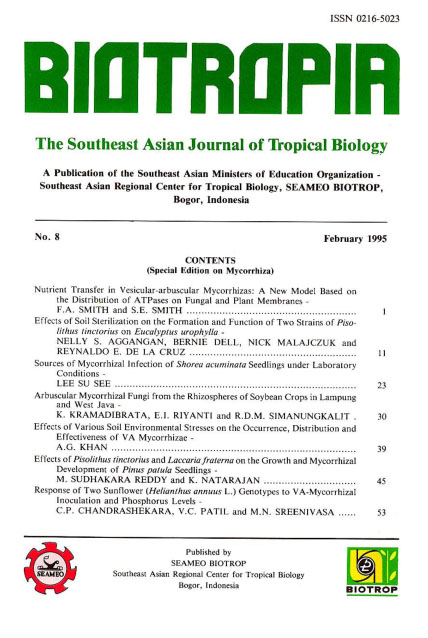
Tags
Department of Botany, The University of Adelaide, South Australia, 5005,
Content Language : English

In this paper we review the membrane transport processes that are involved in the transfer of mineral
nutrients and organic carbon between the symbiotic partners in mycorrhizas. In particular, we reassess the
prevailing hypothesis that transfer in vesicular-arbuscular (VA) mycorrhizas occurs simultaneously and
bidirectionally across the same interface and that arbuscules are the main sites of transfer.
Using cytochemical techniques, we and our collaborators have reexamined the distribution of ATPases
in the arbuscular and intercellular hyphal interfaces in VA mycorrhizas formed between roots ofAllium cepa
(onion) and the fungus Glomus intraradices. The results showed that H
+
-ATPases have different localisation on
plant and fungal membranes in arbuscular and hyphal interfaces (Gianinazzi-Pearson et al. 1991). While some
arbuscular interfaces had H+
-ATPase activity on both fungal and plant membranes, in most cases the fungal
membrane lacked this activity. In contrast, the plasma membranes of intercellular hyphae always had H
+
-ATPase and the adjacent root cells did not. This suggests that the different interfaces in a VA mycorrhiza may
have different functions.
We propose that passive loss of P from the arbuscules is associated with active uptake by the energised
(ATPase-bearing) plant membrane and that passive loss of carbohydrate from the root cells is followed by
active uptake by the intercellular hyphae. If this model is correct, then variations in "mycorrhizal efficiency"
(i.e. the extent to which mycorrhizal plants grow better than non-mycorrhizal controls) might be determined by
differences in the numbers of active arbuscules as a proportion of the total fungal biomass within the root.
As a first step towards investigating this possibility, we have developed methods for measuring the
surface areas of arbuscular and hyphal interfaces in different fungus-host combinations, Glomus spp./ Allium
porrum (leek). We have also measured fluxes of P from fungus to plant and have been able to partition these
between the arbuscular and total (arbuscular plus hyphal) interfaces. The implications of this work, and
suggestions for future investigations of the molecular mechanisms involved in nutrient transfer in mycorrhizas,
are discussed.

This work is licensed under a Creative Commons Attribution-NonCommercial-NoDerivatives 4.0 International License.
